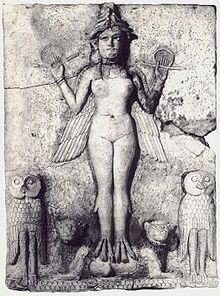| Revision as of 15:15, 25 April 2006 view sourceDpv (talk | contribs)4,945 editsm Disambiguation link repair - You can help! (Sumeria)← Previous edit | Revision as of 10:09, 28 May 2006 view source Ham II (talk | contribs)Extended confirmed users, Pending changes reviewers56,373 edits link British Museum and catNext edit → | ||
| Line 1: | Line 1: | ||
| ] | ] | ||
| The '''Burney Relief''' is an early ] (ca. ]) ]n terracotta relief (alternately said to be "]ian" or "]n") of a winged goddess-figure with ]'s talons, flanked by ]s and perched upon supine ]s. It is in the British |
The '''Burney Relief''' is an early ] (ca. ]) ]n terracotta relief (alternately said to be "]ian" or "]n") of a winged goddess-figure with ]'s talons, flanked by ]s and perched upon supine ]s. It is housed in the ] in ]. The goddess has been identified with the Sumerian ''Kisikil-lilla-ke'' of the ], and, somewhat optimistically, with ] ] ]. | ||
| A very similar relief dating to roughly the same period is preserved in the ] (AO 6501). | A very similar relief dating to roughly the same period is preserved in the ] (AO 6501). | ||
| Line 8: | Line 8: | ||
| ] | ] | ||
| ] | ] | ||
| ] | |||
Revision as of 10:09, 28 May 2006

The Burney Relief is an early 2nd millennium BC (ca. 1950 BC) Mesopotamian terracotta relief (alternately said to be "Sumerian" or "Assyrian") of a winged goddess-figure with eagle's talons, flanked by owls and perched upon supine lions. It is housed in the British Museum in London. The goddess has been identified with the Sumerian Kisikil-lilla-ke of the Gilgamesh epos, and, somewhat optimistically, with 7th century BC Babylonian Lilitu. A very similar relief dating to roughly the same period is preserved in the Louvre (AO 6501).